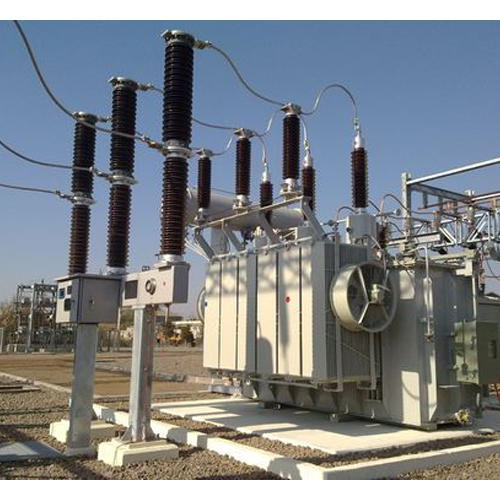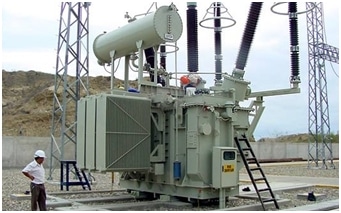A transformer is a static device that transfers electrical energy between two or more circuits through electromagnetic induction. A varying current in one coil of the transformer produces a varying magnetic flux, which, in turn, induces a voltage across a second coil wound around the same core. Electrical energy can be transferred between the two coils, without a metallic connection between them.
Faraday’s law of induction states that: The induced electromotive force (emf) in any closed circuit is proportional to the time rate of change of the magnetic flux through the circuit.
There are many reasons why a transformer is installed in a substation. The most common reason is to change the voltage so that it can be used by the equipment in the substation. Transformers also help to protect against power surges and provide isolation between circuits.
11Kv Transformer Installation Procedure
If you’re looking to install a 11Kv transformer, there are some important things to keep in mind. First, make sure you have the proper equipment and tools for the job. This includes gloves, eye protection, and earplugs.
Next, be aware of your surroundings and make sure you have a clear path to the installation site. Once you’re at the site, follow these steps:
1. Place the transformer on a level surface.
2. Connect the primary winding leads to the proper terminals.
3. Connect the secondary winding leads to the proper terminals.
4. Install any necessary fuses or breakers.
5 .Install any other required hardware according to the manufacturer’s instructions.
6 .
Transformer Installation Procedure Pdf
Transformer Installation Procedure Pdf
A transformer is a device that changes the voltage of an alternating current (AC) electrical power supply. Transformers are used to increase or decrease the voltages of AC circuits, which is necessary for many applications such as domestic appliances, motors, and lighting.
The most common type of transformer is the inductor-type transformer, which uses magnetic induction to change the voltage.
There are three main steps in installing a transformer: mounting the unit, connecting the primary and secondary windings, and grounding the unit. These steps are described in detail below.
1) Mounting the Unit: Transformer units must be mounted on a level surface that can support their weight. The base of the unit should be fastened to the ground with bolts or screws; however, it is important that these fasteners not penetrate any live electrical wires or other energized parts of the system. Once the base is secure,the top half of the housing can be placed over it and secured in place with more bolts or screws.
If your particular model has cooling fins on top, make sure that they are not obstructed by anything so that air can circulate freely around them.
2) Connecting Primary and Secondary Windings: The next step is to connect both primary and secondary windings to their respective terminals. For safety reasons, it is best to do this while wearing rubber gloves and using insulated tools.
First loosen all of the terminal nuts before attaching any wires; then attach each wire one at a time and tighten down its corresponding nut until it is snug but not overly tight (over-tightening can damage insulation). All connections should be made so that like polarities are matched up (i.e., connect positive to positive and negative to negative). Finally, apply a liberal amount of insulating varnish over all exposed terminals and wiring connections to protect against moisture damage.
3) Grounding Unit: It is critical that every transformer be properly grounded in order to protect against electric shock hazards as well as lightning strikes. A good grounding connection will also help prolong the life of your unit by dissipating harmful electrostatic charges build-up within its winding coils. The grounding terminal(s) will be clearly labeled on most models; simply attach a bare copper wire (using an appropriate size connector clamp) from this point directly into an earth ground stake driven into moist soil outside near your installation site.
Transformer Installation Checklist
Transformers are an important part of the electrical grid, and their installation must be done carefully. Here is a checklist to follow when installing a transformer:
1. Make sure the site is prepared for the transformer.
This includes clearing any vegetation or debris from the area where the transformer will be installed, as well as making sure there is enough space for it.
2. Check that all the necessary permits have been obtained.
3. Inspect the transformer itself to make sure it is in good condition and properly rated for the job it will be doing.
4. Install any supporting structures, such as a concrete pad or metal frame, according to manufacturer specifications.
5. Carefully lower the transformer into place and secure it according to manufacturer instructions. This usually involves bolting it down or attaching it to guy wires.
*Make sure that all connections are made correctly and securely before energizing the transformer.* This includes both primary and secondary connections, as well as any grounding electrodes that may be used. Once everything has been checked and double-checked, energize the unit gradually, following manufacturer recommendations – typically this means starting at reduced voltage and then slowly increasing it over time until full voltage is reached.
Power Transformer Installation Procedure
Installing a power transformer is no easy task. There are many factors to consider and the process can be quite involved. Here is a basic overview of the steps involved in installing a power transformer:
1. Choose the right location for the transformer. The transformer must be installed in a dry, well-ventilated area away from any sources of heat or ignition.
2. Unpack the transformer and carefully inspect it for any damage.
If there is any damage, do not install the transformer and contact the manufacturer immediately.
3. Install the foundation bolts that will support the weight of the transformer. The number and size of these bolts will be specified by the manufacturer.
4. Place the transformer onto the foundation bolts and secure it with nuts and washers (also supplied by the manufacturer). Make sure that all connections are tight to prevent leaks.
5 .
Connect the primary winding of the transformer to your power source (typically a high voltage line). Make sure that all connections are made according to code and that proper insulation is used throughout. Never work on energized electrical equipment!
6 . Connect secondary windings as needed for your application (for example, to distribute lower voltages to different parts of your facility). Again, make sure that all connections are made safely and properly insulated .
Types of Substation Transformers
There are three types of substation transformers: step-up, step-down, and isolation. The type of transformer used depends on the application.
A step-up transformer increases the voltage of an alternating current (AC) before it reaches the distribution grid.
The higher voltage reduces power losses in transmission and makes it possible to deliver electricity over long distances. A typical example is a hydroelectric power plant where water turbines generate electricity at low voltages that must be increased for transmission.
A step-down transformer decreases the voltage of an AC before it enters a building or home.
This is necessary because most appliances and devices run on lower voltages than what is found in the distribution grid. For example, a standard North American home has 120-volt household circuits while the distribution grid carries 240 volts.
An isolation transformer blocks currents from flowing between two electrical systems that should not be connected.
This can happen when there is a difference in potential between two systems, such as when one system is grounded and the other is not. Isolation transformers are used to protect sensitive equipment from damage caused by electrical surges or spikes.
Transformer Manual Pdf
Transformer manuals are a great resource for understanding how your transformer works. They can be found online or in most hardware stores. Transformer manuals usually contain specific information about the model of transformer you have, as well as wiring diagrams and other technical information.
Substation Transformer Specification
A substation transformer is a type of power transformer that is used to step down the voltage from the high-voltage transmission system to the low-voltage distribution system. The primary winding of the substation transformer is connected to the high-voltage transmission line, while the secondary winding is connected to the low-voltage distribution line.
The capacity of a substation transformer is typically expressed in terms of megavolt amperes (MVA).
The most common voltages for substation transformers are 72.5 kV, 115 kV, 138 kV, and 161 kV.
There are two main types of substation transformers: oil-filled and dry-type. Oil-filled transformers are generally more expensive than dry-type transformers, but they offer several advantages, such as a longer life span and better resistance to environmental conditions (e.g., dust, moisture).
When selecting a substation transformer, it is important to consider various factors, such as cost, efficiency, size, and compatibility with other equipment.

Credit: www.electricityforum.com
What are the Steps for Installing Transformer?
Installing a transformer is not as difficult as one might think. With just a few simple steps, one can have a new transformer up and running in no time. Here are the steps for installing a transformer:
1) Choose the proper location for the transformer. It is important to find a spot that is level and free of any debris or obstructions. The area should also be well-ventilated to avoid any potential overheating issues.
2) Connect the primary winding of the transformer to the power source. This can be done by using either high-voltage wire or bus bars. Make sure all connections are tight and secure to avoid any accidents.
3) Mount the transformer onto its base or foundation. Again, it is important to make sure the mounting surface is level and free of any obstructions. Once the transformer is mounted, connect the secondary winding of the transformer to whatever load you are powering (e.g., lights, motors, etc.).
4) Finally, turn on the power source and test everything out! If all goes well, your new transformer should be up and running without any issues.
What Transformer is Used in Substation?
A transformer is a device that changes the voltage of an alternating current (AC). The transformer at a substation increases the voltage from the low level used in homes to the high level needed to transmit electricity over long distances.
Which Points to Be Considered While Installing Transformers?
There are a few important points to keep in mind while installing transformers:
1. Transformers should be installed on a level surface to ensure proper operation.
2. The transformer should be positioned so that the primary and secondary coils are aligned.
This will help minimize losses.
3. All connections should be made tight and secure to prevent any electrical issues.
4. Make sure all wiring is correct before energizing the transformer.
Incorrect wiring can cause serious damage to the transformer or other equipment.
Where are Transformers Installed?
Transformers are installed at the substation, which is typically located near the center of the distribution area. The substation contains high-voltage equipment that transforms the energy from the transmission system to a lower voltage for distribution to customers.
TRANSFORMER INSTALLATION
Conclusion
The article discusses the installation of a transformer in a substation. It outlines the different types of transformers and the steps involved in their installation. Transformer installation is a critical part of power system infrastructure and proper care must be taken to ensure that it is done correctly.

